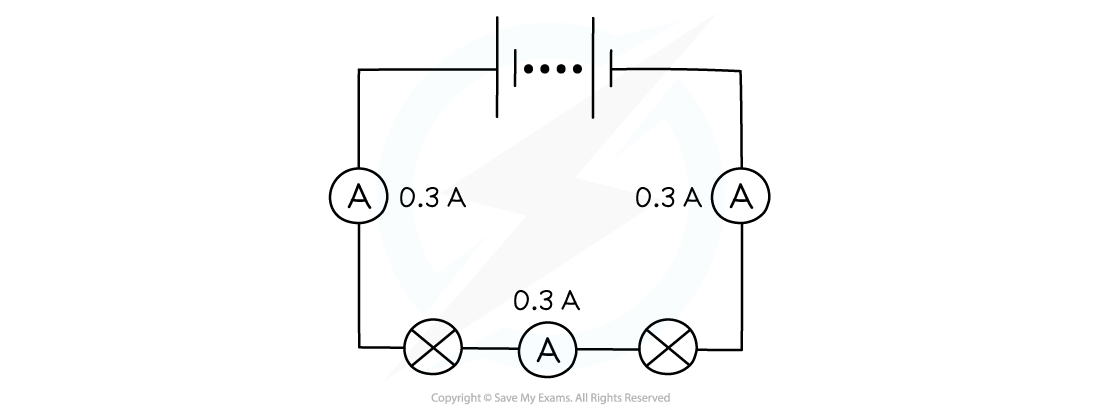Potential difference can be measured by connecting a voltmeter in parallel between two points in a circuit
Charge & Current (AQA GCSE Physics: Combined Science)
Revision Note

Author
AshikaExpertise
Physics Project Lead
Source of Potential Difference
- For electrical charge to flow through a closed circuit, it must include a source of potential difference (p.d)
- Sources of potential difference include:
- A cell
- Batteries (multiple cells)
- Electrical generator
- A cell makes one end of the circuit positive and the other negative
- This sets up a potential difference across the circuit
- This is sometimes known as the voltage
- The symbol for potential difference is V
- The potential difference across a component in a circuit is defined as
The energy transferred per unit charge flowing from one point to another
- The energy transferred can also be called the work done
- This is calculated using the equation:

- Potential difference is measured in volts (V). This is the same as a Joule per coulomb (J C-1)
- If a bulb has a voltage of 3 V, every coulomb of charge passing through the bulb will lose 3 J of energy
- Potential difference (or voltage) is measured using a voltmeter
- A voltmeter is always set up in parallel to the component you are measuring the potential difference across

Worked example
Calculate the work done in moving a charge of 5 C through a potential difference of 20 V.
Step 1: Write down the known quantities
- Charge, Q = 5 C
- Potential difference, V = 20 V
Step 2: Write down the relevant equation

Step 3: Rearrange for the work done, W
W = VQ
Step 4: Substitute in the values
W = 20 × 5 = 100 J
Electric Current
- Electric current is the flow of electrical charge
- It is measured in units of amperes (A) or amps
- The symbol for current is I
- The size of the electric current is the rate of flow of electrical charge
- In other words, how much charge passes through a point each second
- In metals, such as a copper wire, the electrical charge that flows is electrons
- Therefore, the current in a circuit is a flow of electrons

In metals, the current is caused by a flow of electrons
- The unit of charge is the Coulomb (C)
- This is defined as the quantity of charge that passes a fixed point per second when a current of 1 A is flowing
- The coulomb (C), is equal to the quantity of electricity conveyed in one second by a current of one ampere i.e. 1 C = 1 A s
- Charge flow, current and time are related by the equation:

- This equation can be rearranged with the help of the following formula triangle:

Worked example
Calculate the current through a lamp when a charge of 4 C passes through it in 500 s.
Step 1: Write down the known quantities
- Charge, Q = 4 C
- Time, t = 500 s
Step 2: Write down the relevant equation
Q = It
Step 3: Rearrange for current, I

Step 4: Substitute in the values


In my experience, students can often confuse charge and current. When we say charge in terms of electrical circuits, we are really talking about a quantity of electrons. A unit of charge, one coulomb (1 C) is 6.24 × 1018 electrons. Because that is such a large number, I like to imagine in my head little buckets of electrons worth 1 C of charge (but of course electrons don't travel in buckets!). When delocalised electrons flow around a circuit, the amount of charge passing a fixed point (like an ammeter) per second is the current. So an ammeter is basically counting the number of electrons or the amount of charge flowing through it each second. One amp (1 A) of current is one coulomb of charge per second (1 C / s).
Current in a Loop
- Electrons are negatively charged
- Therefore, they flow away from the negative terminal of a cell towards the positive terminal
- Conventional current is defined as the flow of positive charge from the positive terminal of a cell to the negative terminal
- This is opposite to the direction of electron flow, this is because conventional current was being put to use before the discovery of the electron

By definition, conventional current always goes from positive to negative (even through electrons go the other way)
- Current is measured using an ammeter
- Ammeters should always be connected in series with the part of the circuit you wish to measure the current through

An ammeter can be used to measure the current around a circuit and always connected in series
- In a circuit that is a closed-loop, such as a series circuit, the current is the same value at any point
- This is because the number of electrons per second that passes through one part of the circuit is the same number that passes through any other part
- This means that all components in a closed-loop have the same current

The current is the same at each point in a closed-loop

You've read 0 of your 0 free revision notes
Get unlimited access
to absolutely everything:
- Downloadable PDFs
- Unlimited Revision Notes
- Topic Questions
- Past Papers
- Model Answers
- Videos (Maths and Science)
Did this page help you?